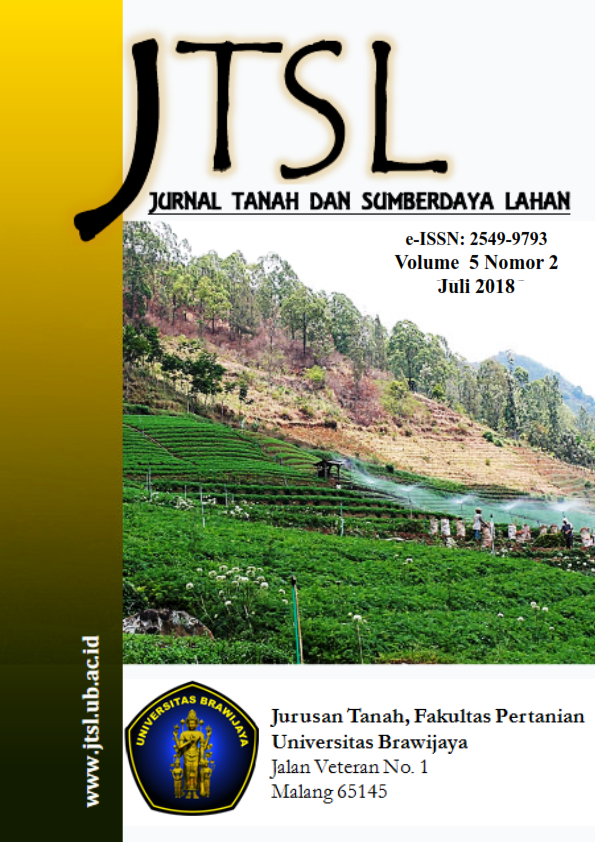PENGARUH KOMPOS TERHADAP SIFAT FISIK TANAH DAN PERTUMBUHAN TANAMAN JAGUNG DI INCEPTISOL
Keywords:
soil phisycs, organic matter, inceptisol, plant growtAbstract
The purpose of this study was to elucidate the effect of composting on changes in soil physical properties and to examine the relationship of soil physics properties with plant growth. The method used is a completely randomized block design implemented on the moor land located in the Village Lojejer Wuluhan District, East Java Jember. The study was conducted on 750 m2 of land with an altitude of 14 above sea level. Type of soil that is found in the research field is an Inceptisol having organic material content of 1.1%. Parameters measured aggregate stability, soil pore, bulk density, organic hatter, plant height, leaf number, wet weight of plant, and dry weight of plant. The results showed that addition of several doses of compost improved physical properties of the soil studied. The addition of compost increased the amount of microbes in the soil that played as soil adhesive agents that make the stabile soil aggregate. The soil aggregates stability could increase pores and decrease the weight of the soil content. Composting did not affect the growth of plants because at the time of vegetative growth compost did significantly effect soil physical characteristics.
References
Agusni, M. dan Satriawan, H. 2014. Pengaruh olah tanah dan pemberian pupuk kandang terhadap sifat fisik tanah dan produksi tanaman jagung. Lentera. 14 (11) : 1-6.
Arifiati, A., Syekhfani, dan Nuraini, Y. 2017. Uji efektivitas perbandingan bahan kompos paitan (Tithonia diversifolia), Tumbuhan Paku (Dryopteris filixmas), dan kotoran kambing terhadap serapan N tanaman jagung pada inceptisol. Jurnal Tanah dan Sumberdaya Lahan. 4 (2) : 543-552.
Brata, K.R. dan Nelistya, A. 2008. Lubang Serapan Biopori. Penebar Swadaya. Jakarta.
Buckman, H.O. dan Brady, N.C. 1982. Ilmu Tanah. Bhratara Karya Aksara. Jakarta.
Habi, M.L. 2015. Pengaruh aplikasi kompos granul ela sagu diperkaya pupuk Ponska terhadap sifat fisik tanah dan hasil jagung manis di inceptisol. Biopendix. 1 (2) : 121 – 134.
Hanafiah, K.A. 2013. Dasar-Dasar Ilmu Tanah. Rajawali Pers. Jakarta.
Indriani, Y.H. 2007. Membuat Kompos Secara Kilat. Penebar Swadaya. Jakarta.
Isrun. 2010. Perubahan serapan nitrogen tanaman jagung dan kadar Al-dd akibat pemberian kompos tanaman legum dan nonlegum pada Inseptisols Napu. Jurnal Agroland 7 (1) : 23-29.
Muyassir, Sufardi, dan Saputra, I. 2012. Perubahan sifat fisika Inceptisol akibat perbedaan jenis dan dosis pupuk organik. Lentera 12 (1): 1-8.
Prasetyo, Y., Djatmiko, H. dan Sulistyaningsih, N. 2014. Pengaruh kombinasi bahan baku dan dosis biochar terhadap perubahan sifat fisika tanah pasiran pada tanaman jagung (Zea mays L.). Berkala Ilmiah Pertanian. 1 (1) : 1-5.
Rachman, I.A., Djuniwati, S. dan Idris, K. 2008. Pengaruh bahan organik dan pupuk NPK terhadap serapan hara dan produksi jagung di Inceptisol Ternate. Jurnal Tanah dan Lingkungan 10 (1) : 7-13.
Rachman, L.M., Latifa, N. dan Nurida, N.L. 2015. Efek Sistem Pengolahan Tanah Terhadap Bahan Organik Tanah, Sifat Fisik Tanah, dan Produksi Jagung pada Tanah Podsolik Merah Kuning di Kabupaten Lampung Timur. Prosiding Seminar Nasional Lahan Suboptimal Palembang.
Refliaty, Tampubolon, G. dan Hendriansyah. 2011. Pengaruh pemberian kompos sisa biogas kotoran sapi terhadap perbaikan beberapa sifat fisik Ultisol dan hasil kedelai (Glycine max (L.) Merill). Jurnal Hidrolitan 2 (3): 103-114.
Rosmarkam, A. dan Yuwono, N.W. 2002. Ilmu Kesuburan Tanah. kanisius. Yogyakarta.
Sertua, H., Lubis, J.A. dan Marbun, P. 2014. Aplikasi kompos ganggang cokelat (Sargassum polycystum) diperkaya pupuk N, P, K terhadap Inseptisol dan jagung. Jurnal Online Agroekoteknologi. 2 (4): 1538 – 1544.
Sutanto, R. 2002. Pertanian Organik. Kanisius. Yogyakarta.
Utomo., W.H. 1995. Erosi Dan Konservasi Tanah. Universitas Brawijaya. Malang
Downloads
Published
How to Cite
Issue
Section
License
The copyright of the received article shall be assigned to the journal as the publisher of the journal. The intended copyright includes the right to publish the article in various forms (including reprints). The journal maintains the publishing rights to the published articles.

This work is licensed under a Creative Commons Attribution-NonCommercial 4.0 International License.













